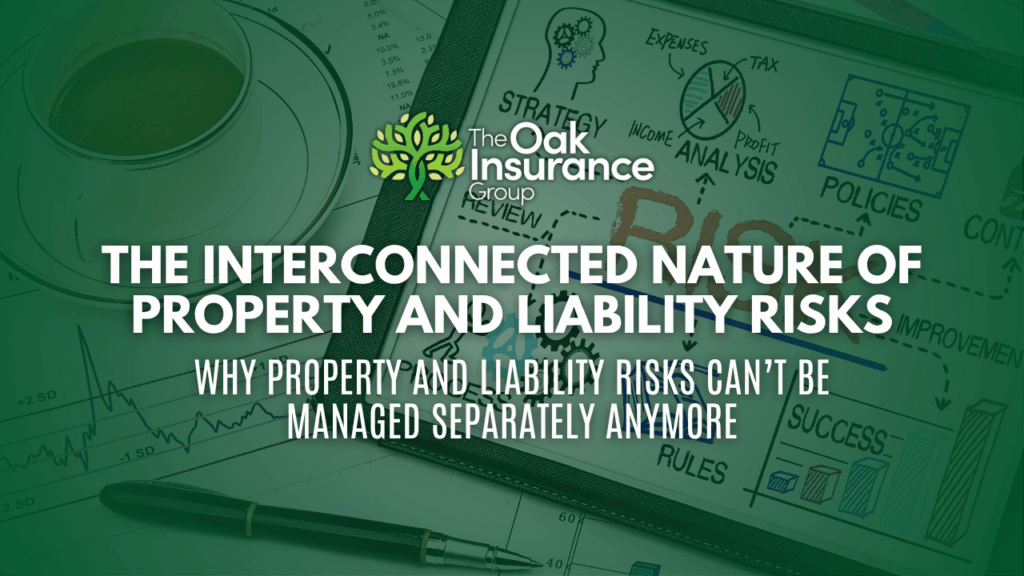
If your organization still treats property and liability insurance as two separate conversations, you’re likely underestimating your exposure. In today’s volatile landscape, a single incident can cause millions in physical damage, operational disruption, and legal claims—often at the same time.
We’ve worked with companies across industries who thought they had adequate coverage until disaster struck. What they discovered too late was that disconnected policies and outdated risk models left them vulnerable to cascading losses and policy gaps.
In this article, you’ll learn why the old siloed approach to risk management no longer works, how property and liability exposures intersect, and what you can do now to build a more resilient, integrated protection strategy.
Understanding Property and Liability Risk in Today’s Environment
Modern Property Risk Includes More Than Physical Loss
Traditionally, property risk referred to damage or loss of tangible assets. Today, that definition has evolved. One incident can trigger a complex chain of consequences—disrupted operations, reputational fallout, and even regulatory scrutiny.
Property damage is no longer just a physical issue—it’s the starting point for financial and operational disruption.
Standard property policies often exclude events like floods or cyber-triggered shutdowns unless explicitly added. Worse, underinsurance delays recovery and may amplify losses by triggering business interruption or third-party disputes.
Liability Risk Now Covers Digital, Legal, and Third-Party Harm
Liability risk once focused on physical injury or damage caused to others. But as companies grow more connected—digitally and globally—exposure now includes cybersecurity breaches, misinformation on social media, vendor errors, and professional negligence.
One failure—technical, operational, or interpersonal—can now spark lawsuits, brand damage, and regulatory fines.
Coverage types include general liability, professional liability, cyber liability, and others. But policy lines are increasingly blurred, as a single event may trigger multiple categories of harm and leave critical gaps between them.
Why These Risks Are Interconnected—and Why It Matters More Than Ever
Three Forces Are Driving Risk Convergence
- Climate Instability: Natural disasters no longer cause just physical damage—they interrupt business continuity and trigger liability claims over negligence or poor planning.
- Digital Dependency: Cyber incidents often damage both virtual systems and physical operations, while also triggering regulatory and legal actions.
- Socio-Economic Volatility: Today’s supply chains and customer networks mean a single failure can affect dozens of stakeholders and spawn legal action across jurisdictions.
These forces don’t operate in isolation—they amplify one another.
Real-World Events That Prove the Point
- CrowdStrike Outage (2024): A botched software update cost an estimated $10B in property damage, lost income, and lawsuits within 24 hours.
- Lahaina and Marshall Fires: Underinsurance worsened recovery timelines and led to legal claims against government and utility agencies.
- Texas Power Crisis (2021): Infrastructure failures led to physical losses, fatalities, and class-action lawsuits—showing how quickly one risk triggers another.
The lesson: In modern risk events, property and liability losses unfold side-by-side.
How One Risk Triggers Another—and Why That Exposes You
Property Loss Is the Beginning, Not the End
A flood may damage your facility—but when that damage prevents tenants from reopening or customers from receiving products, lawsuits often follow.
Physical loss now initiates financial, legal, and reputational consequences.
The same applies to construction defects, product failures, and environmental spills. One event, multiple consequences.
Liability Events Can Lead to Physical and Operational Fallout
A major lawsuit might require facility upgrades, suspend operations, or reduce occupancy due to reputational harm. Regulatory investigations could mandate equipment shutdowns or structural modifications.
What begins as a legal problem may end in physical disruption.
Business Interruption Is the Critical Link Between Risks
When business operations halt—due to cyberattack, natural disaster, or litigation—the impact spans both insurance domains. Yet many policies only cover interruption triggered by direct physical loss, leaving digital or legal disruptions uninsured.
Business interruption is now the most financially damaging and often the least adequately covered risk.
How Forward-Thinking Companies Are Redesigning Risk Strategy
1. Integrated Risk Assessments Are Becoming Standard
Siloed risk audits no longer suffice. Cross-departmental teams—including legal, IT, operations, and facilities—are mapping interdependencies between risks. Simulating cascading events reveals unseen vulnerabilities.
When you test for multi-risk scenarios, you expose the real fault lines in your protection.
2. Insurance Programs Are Being Rebuilt Around Overlap
Progressive companies are moving beyond piecemeal policies. They’re:
- Auditing policy overlap to identify gaps
- Purchasing cyber-physical bundled coverage
- Using captives to create custom, cross-domain protection
- Redrafting deductibles and claims language to reflect interconnected risk
Insurance isn’t just protection—it’s now strategic architecture.
3. Proactive Resilience Is the New Benchmark
It’s no longer enough to react to disaster. Leaders are investing in:
- Real-time early warning systems
- Continuity plans that cover multiple departments and partners
- Redundant supply strategies
- Crisis communication playbooks to limit brand damage
Resilience means maintaining operations—even when disaster strikes.
Where Risk Management Goes From Here
In the past, companies tried to patch holes in individual risk categories. But today’s landscape doesn’t allow for isolation—every leak connects to another. Physical damage leads to lawsuits. Cyber failure leads to property loss. Reputational harm leads to financial collapse.
You’ve now seen how separate risk categories no longer reflect reality. If you’re still managing them in silos, you may be unintentionally exposed to cascading losses your policies don’t cover.
That’s why forward-thinking organizations are reengineering their risk strategies to reflect how risk truly unfolds—interconnected, simultaneous, and compounding.
Now that you understand the true cost of disconnection, it’s time to reevaluate your risk portfolio. Map where one failure could create multiple claims. Audit your policies for gaps between property, liability, and income protection. And most importantly—start building a strategy for the risks of tomorrow, not just the risks of yesterday.

